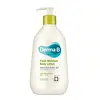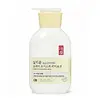What's inside
What's inside
 Key Ingredients
Key Ingredients

 Benefits
Benefits

 Concerns
Concerns

 Ingredients Side-by-side
Ingredients Side-by-side

Water
Skin ConditioningCyclopentasiloxane
EmollientGlycerin
HumectantCetearyl Alcohol
EmollientSorbitan Stearate
Emulsifying1,2-Hexanediol
Skin ConditioningGlyceryl Stearate
EmollientPropanediol
SolventCaprylic/Capric Triglyceride
MaskingStearic Acid
CleansingPalmitic Acid
EmollientOleic Acid
EmollientLinoleic Acid
CleansingLinolenic Acid
CleansingTocopherol
AntioxidantCetyl Ethylhexanoate
EmollientButyrospermum Parkii Butter
Skin ConditioningVitis Vinifera Seed Oil
EmollientPanthenol
Skin ConditioningSodium Hyaluronate
HumectantPhytosterols
Skin ConditioningArachis Hypogaea Seedcoat Extract
Skin ConditioningSapindus Trifoliatus Fruit Extract
Skin ConditioningSpirulina Platensis Extract
Skin ProtectingTriticum Vulgare Sprout Extract
Skin ConditioningBrassica Oleracea Italica Extract
AstringentSaussurea Involucrata Extract
HumectantDiospyros Kaki Leaf Extract
Skin ProtectingBambusa Vulgaris Extract
Skin ConditioningChenopodium Quinoa Seed Extract
Skin ConditioningButylene Glycol
HumectantDimethicone
EmollientCarbomer
Emulsion StabilisingXanthan Gum
EmulsifyingArginine
MaskingDisodium EDTA
Caprylyl Glycol
EmollientEthylhexylglycerin
Skin ConditioningPropylene Glycol
HumectantSodium Benzoate
MaskingParfum
MaskingWater, Cyclopentasiloxane, Glycerin, Cetearyl Alcohol, Sorbitan Stearate, 1,2-Hexanediol, Glyceryl Stearate, Propanediol, Caprylic/Capric Triglyceride, Stearic Acid, Palmitic Acid, Oleic Acid, Linoleic Acid, Linolenic Acid, Tocopherol, Cetyl Ethylhexanoate, Butyrospermum Parkii Butter, Vitis Vinifera Seed Oil, Panthenol, Sodium Hyaluronate, Phytosterols, Arachis Hypogaea Seedcoat Extract, Sapindus Trifoliatus Fruit Extract, Spirulina Platensis Extract, Triticum Vulgare Sprout Extract, Brassica Oleracea Italica Extract, Saussurea Involucrata Extract, Diospyros Kaki Leaf Extract, Bambusa Vulgaris Extract, Chenopodium Quinoa Seed Extract, Butylene Glycol, Dimethicone, Carbomer, Xanthan Gum, Arginine, Disodium EDTA, Caprylyl Glycol, Ethylhexylglycerin, Propylene Glycol, Sodium Benzoate, Parfum
Water
Skin ConditioningButylene Glycol
HumectantAlcohol Denat.
AntimicrobialGlycerin
HumectantDimethicone
EmollientNiacinamide
SmoothingSqualane
EmollientCyclopentasiloxane
EmollientCamellia Oleifera Leaf Extract
AstringentCitrus Limon Peel Oil
MaskingCitrus Limon Fruit Extract
MaskingPanax Ginseng Root Extract
EmollientGardenia Taitensis Callus Extract
AntioxidantTheobroma Cacao Extract
Skin ConditioningGlyceryl Stearate
EmollientDimethiconol
EmollientBehenyl Alcohol
EmollientBis-PEG-18 Methyl Ether Dimethyl Silane
EmollientCetyl Ethylhexanoate
EmollientArachidyl Glucoside
EmulsifyingArachidyl Alcohol
EmollientCarbomer
Emulsion StabilisingTromethamine
BufferingPEG-100 Stearate
Dextrin
AbsorbentDisodium EDTA
Phenoxyethanol
PreservativeParfum
MaskingWater, Butylene Glycol, Alcohol Denat., Glycerin, Dimethicone, Niacinamide, Squalane, Cyclopentasiloxane, Camellia Oleifera Leaf Extract, Citrus Limon Peel Oil, Citrus Limon Fruit Extract, Panax Ginseng Root Extract, Gardenia Taitensis Callus Extract, Theobroma Cacao Extract, Glyceryl Stearate, Dimethiconol, Behenyl Alcohol, Bis-PEG-18 Methyl Ether Dimethyl Silane, Cetyl Ethylhexanoate, Arachidyl Glucoside, Arachidyl Alcohol, Carbomer, Tromethamine, PEG-100 Stearate, Dextrin, Disodium EDTA, Phenoxyethanol, Parfum
Ingredients Explained
These ingredients are found in both products.
Ingredients higher up in an ingredient list are typically present in a larger amount.
Butylene Glycol (or BG) is used within cosmetic products for a few different reasons:
Overall, Butylene Glycol is a safe and well-rounded ingredient that works well with other ingredients.
Though this ingredient works well with most skin types, some people with sensitive skin may experience a reaction such as allergic rashes, closed comedones, or itchiness.
Learn more about Butylene GlycolCarbomer is a polymer of acrylic acid. Its main role is to create a gel consistency.
A high amount of carbomer can cause pilling or balling up of products. Don't worry, most products contain 1% or less of carbomer.
Cetyl Ethylhexanoate is an emollient ester. It comes from cetearyl alcohol and 2-ethylhexanoic acid.
Cetyl Ethylhexanoate is an emollient that adds a velvety feel to skin without being greasy or oily. Emollients help trap moisture into your skin, keeping your skin soft and hydrated.
Cyclopentasiloxane, or D5, is a silicone used to improve texture of products and trap moisture.
D5 is considered lightweight and volatile. Volatile means it evaporates quickly after application. Once evaporated, D5 leaves a thin barrier that helps keep skin hydrated.
It is also an emollient. Emollients help soften the skin and prevent water loss. Silicones create a silky texture in products. D5 helps other ingredients become more spreadable.
Studies show D5 is safe to use in skincare products. We recommend speaking with a skincare professional if you have concerns.
Learn more about CyclopentasiloxaneDimethicone is a type of synthetic silicone created from natural materials such as quartz.
What it does:
Dimethicone comes in different viscosities:
Depending on the viscosity, dimethicone has different properties.
Ingredients lists don't always show which type is used, so we recommend reaching out to the brand if you have questions about the viscosity.
This ingredient is unlikely to cause irritation because it does not get absorbed into skin. However, people with silicone allergies should be careful about using this ingredient.
Note: Dimethicone may contribute to pilling. This is because it is not oil or water soluble, so pilling may occur when layered with products. When mixed with heavy oils in a formula, the outcome is also quite greasy.
Learn more about DimethiconeDisodium EDTA plays a role in making products more stable by aiding other preservatives.
It is a chelating agent, meaning it neutralizes metal ions that may be found in a product.
Disodium EDTA is a salt of edetic acid and is found to be safe in cosmetic ingredients.
Learn more about Disodium EDTAGlycerin is already naturally found in your skin. It helps moisturize and protect your skin.
A study from 2016 found glycerin to be more effective as a humectant than AHAs and hyaluronic acid.
As a humectant, it helps the skin stay hydrated by pulling moisture to your skin. The low molecular weight of glycerin allows it to pull moisture into the deeper layers of your skin.
Hydrated skin improves your skin barrier; Your skin barrier helps protect against irritants and bacteria.
Glycerin has also been found to have antimicrobial and antiviral properties. Due to these properties, glycerin is often used in wound and burn treatments.
In cosmetics, glycerin is usually derived from plants such as soybean or palm. However, it can also be sourced from animals, such as tallow or animal fat.
This ingredient is organic, colorless, odorless, and non-toxic.
Glycerin is the name for this ingredient in American English. British English uses Glycerol/Glycerine.
Learn more about GlycerinGlyceryl Stearate is a mix of glycerin and stearic acid.
It is used to stabilize the mixing of water and oil ingredients. By preventing these ingredients from separating, it can help elongate shelf life. It can also help thicken the product's texture.
As an emollient, it helps soften skin and supports barrier-replenishing ingredients.
In cosmetics, Glyceryl Stearate is often made from vegetable oils or synthetically produced.
This ingredient may not be fungal-acne safe
Fun fact: The human body also creates Glyceryl Stearate naturally.
Learn more about Glyceryl StearateParfum is a catch-all term for an ingredient or more that is used to give a scent to products.
Also called "fragrance", this ingredient can be a blend of hundreds of chemicals or plant oils. This means every product with "fragrance" or "parfum" in the ingredients list is a different mixture.
For instance, Habanolide is a proprietary trade name for a specific aroma chemical. When used as a fragrance ingredient in cosmetics, most aroma chemicals fall under the broad labeling category of “FRAGRANCE” or “PARFUM” according to EU and US regulations.
The term 'parfum' or 'fragrance' is not regulated in many countries. In many cases, it is up to the brand to define this term.
For instance, many brands choose to label themselves as "fragrance-free" because they are not using synthetic fragrances. However, their products may still contain ingredients such as essential oils that are considered a fragrance by INCI standards.
One example is Calendula flower extract. Calendula is an essential oil that still imparts a scent or 'fragrance'.
Depending on the blend, the ingredients in the mixture can cause allergies and sensitivities on the skin. Some ingredients that are known EU allergens include linalool and citronellol.
Parfum can also be used to mask or cover an unpleasant scent.
The bottom line is: not all fragrances/parfum/ingredients are created equally. If you are worried about fragrances, we recommend taking a closer look at an ingredient. And of course, we always recommend speaking with a professional.
Learn more about ParfumWater. It's the most common cosmetic ingredient of all. You'll usually see it at the top of ingredient lists, meaning that it makes up the largest part of the product.
So why is it so popular? Water most often acts as a solvent - this means that it helps dissolve other ingredients into the formulation.
You'll also recognize water as that liquid we all need to stay alive. If you see this, drink a glass of water. Stay hydrated!
Learn more about Water